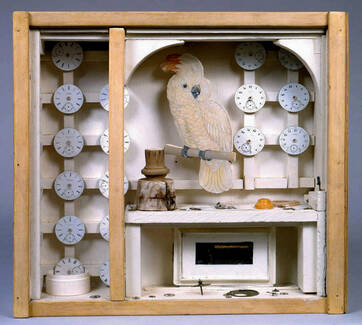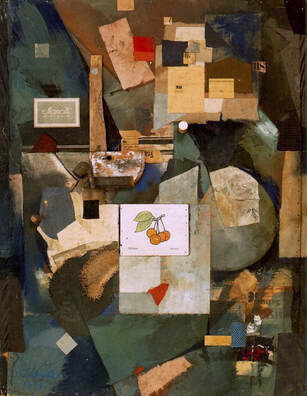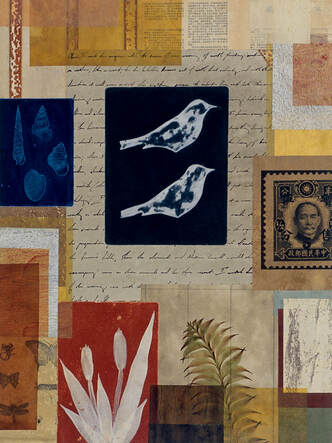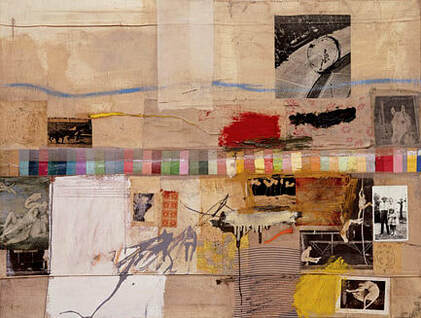Process
Collage and Assemblage: History and Process
|
Andrew Young exhibition brochure - foreword text,
Hidell Brooks Gallery, Charlotte, NC, 2004: Ever since the advent of Cubism, artists have combined elements of the “real” world with their painting to produce works that contain both object and representational features. Contrary to the familiar perspective space of the Renaissance, where the painted surface acts as a window through which we perceive a purely illusionary realm, the picture space of collage lies in front of the plane, created by the actual overlapping of layers of assembled materials. |
Pablo Picasso, 1881-1973
La bouteille de Suze (Bottle of Suze), 1912 Pasted papers, gouache, charcoal, 26 x 20 in. Collection of Mildred Lane Kemper Art Museum |
|
Joseph Cornell, 1903-1972
Untitled (Cockatoo with Watch Faces), 1949 Box construction with inoperative music box, 16 x 17 x 4.5 in, The Lindy and Edwin Bergman Collection |
Just as artists are often identified with people and places on the fringes of society, so can they see the pedestrian, the ugly, the bruised and weathered as material that could reveal significant meaning. Though shaped and combined, even painted upon to lend value in a graphic way, “found” materials still do not lose their original identity, their history or status outside the place of art.
|
|
Throughout subsequent movements in twentieth century art – be it Dada, Surrealism or Pop – the incorporation of existing elements into an artwork retained a certain chanceful and intuitive dimension to its reading, sometimes integrating events as disparate as the unconscious and commercial.
In this way, Collage and Assemblage, having an identity of their own, become a bridge to the physical and familiar: the artwork as a whole takes on a sort of magical self-sufficiency between the known world and the illusory. Playful, personally poetic, or even bizarre, visual artists working in such a manner today lend a profoundly human dimension to Modernism’s abstract language. – Andrew Young |
Kurt Schwitters, 1887-1948
VIII Merzbild 32A. Das Kirschbild (The Cherry Picture), 1921. Assemblage, 36 x 28 in. Collection of The Museum of Modern Art, New York |
|
Andrew Young, Fables and Seas series (c-145), 2000
Collage of hand-painted papers with found stamp and Chinese text on museum board, 31 x 23.5 in. |
Materials:
The materials in my mixed media constructions, collage or otherwise, are fixed and archival. Starting with pure powdered pigments, I make my own paints by creating an emulsion of gum arabic and glycerin mixed in with the mineral color. Often times, these natural sands and powders are collected and processed from nature by me; an array of deep reds and terra cottas come from areas as far-ranging as the Salt Region of central Pakistan, or the ancient strata of our own Grand Canyon. Sun-bleached ochres and earthy umbers were similarly extracted from the oxide-rich layers of the Southwest, and a creamy white paste can result from the crushing of the mother-of-pearl inside freshwater clams. Acid-free Bristol drawing paper and pH-neutral rice pages are stained and coated with the new paint and laid down on cotton museum board with bookbinder’s glue (PVA, or Poly-vinyl acetate: a stable polymer). |
|
Incising, abrading, folding and any other physical technique of “weathering” the papers so as to look as though they’ve had a previous life or utility, is done purely by hand, using elementary painting and printmaking instruments. In the uncommon occurrence of directly appropriated materials, such as vintage photographs, stamps or text, these pieces are treated so as to make them more chemically stable for longer preservation. In the case where a finished artwork is framed, it is always attached to a linen or cotton matte ground, using conservator’s gum and cloth hinges. The “hand made” dimension of my work is critical, not only to its stability as an object, but to the intimacy of its overall reading.
|
Robert Rauschenberg, 1925-2008
Small Rebus, 1956. Assemblage, 35 x 46 x 2 in. The Museum of Contemporary Art, Los Angeles |
© The above artworks may be protected by copyright. They are posted on this site in accordance with
fair use principles, and are only being used for informational and educational purposes.
fair use principles, and are only being used for informational and educational purposes.




